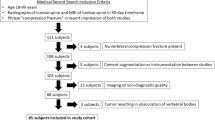Abstract
Introduction
Isolated fractures of the greater trochanter (GT) are relatively rare. The diagnosis can be done on routine radiographs, but it is difficult to fully define the geographic extent of these injuries. This study examined the pattern and extent of an injury shown by magnetic resonance imaging (MRI) and radionuclide bone scan (RBS) in patients whose plain radiographs revealed fractures limited to the GT.
Materials and methods
Between July 2004 and October 2008, 25 patients who displayed an isolated GT fracture on plain radiograph examination were examined by both MRI and RBS due to a suspicion of an extension into the intertrochanteric (ITC) region. The patients were then divided into two groups. Group A patients had an isolated fracture of GT, and group B patients had an occult fracture of ITC.
Results
All 25 cases were caused by a low-energy injury and plain radiographs showed non-displaced or minimally displaced isolated GT fractures. For 22 of the 25 patients, the result agreed with MRI and RBS. However, three patients had focal increased uptake at the GT region only according to RBS and an extension of signal intensity into the ITC region according to MRI. Group A and B comprised 5 and 20 patients, respectively. Of the group B patients, 8 had fractures with MRI evidence of complete extension across the ITC region and 12 had incomplete extension. Eleven of the 12 incomplete types showed an extension more than half way to the medial cortex. Fifteen group B patients underwent an internal fixation using a two-hole dynamic hip screw.
Conclusion
Patients with an isolated fracture of GT can have a broader fracture extending into the ITC region than that diagnosed by standard radiographs. We recommend that all patients presenting with an isolated GT fracture on the plain radiographs should undergo MRI examination.



Similar content being viewed by others
References
Armstrong GE (1907) Isolated fracture of the great trochanter. Ann Surg 46(2):292–297
Blickenstaff LD, Morris JM (1966) Fatigue fracture of the femoral neck. J Bone Joint Surg Am 48(6):1031–1047
Craig JG, Moed BR, Eyler WR, van Holsbeeck M (2000) Fractures of the greater trochanter: intertrochanteric extension shown by MR imaging. Skeletal Radiol 29(10):572–576
Deutsch AL, Mink JH, Waxman AD (1989) Occult fractures of the proximal femur: MR imaging. Radiology 170(1):113–116
Feldman F, Staron RB (2004) MRI of seemingly isolated greater trochanteric fractures. AJR Am J Roentgenol 183(2):323–329
Haramati N, Staron RB, Barax C, Feldman F (1994) Magnetic resonance imaging of occult fractures of the proximal femur. Skeletal Radiol 23(1):19–22
Holder LE, Schwarz C, Wernicke PG, Michael RH (1990) Radionuclide bone imaging in the early detection of fractures of the proximal femur (hip): multifactorial analysis. Radiology 174(2):509–515
Kim SJ, Park BM, Yang KH, Kim DY (1988) Isolated fractures of the greater trochanter. Report of 6 cases. Yonsei Med J 29(4):379–383
Koval KJ, Zuckerman JD (1994) Functional recovery after fracture of the hip. J Bone Joint Surg Am 76(5):751–758
Matin P (1979) The appearance of bone scans following fractures, including immediate and long-term studies. J Nucl Med 20(12):1227–1231
Merlino AF, Nixon JE (1969) Isolated fractures of the greater trochanter. Report of twelve cases. Int Surg 52(2):117–124
Milch H (1939) Avulsion fracture of the great trochanter. Arch Surg 38:334–350
Omura T, Takahashi M, Koide Y, Ohishi T, Yamanashi A, Kushida K, Inoue T (2000) Evaluation of isolated fractures of the greater trochanter with magnetic resonance imaging. Arch Orthop Trauma Surg 120(3–4):195–197
Ostrum RF, Chao EYS, Bassett CAL, Brighton CT, Einhorn TA, Lucas TS, Aro HT, Spector M (1994) Bone injury, regeneration and repair. In: Simon SR (ed) Orthopaedic basic science, 1st edn. American Academy of Orthopaedic Surgeons, Rosemont, pp 277–323
Quinn SF, McCarthy JL (1993) Prospective evaluation of patients with suspected hip fracture and indeterminate radiographs: use of T1-weighted MR images. Radiology 187(2):469–471
Rizzo PF, Gould ES, Lyden JP, Asnis SE (1993) Diagnosis of occult fractures about the hip magnetic resonance imaging compared with bone-scanning. J Bone Joint Surg Am 75(3):395–401
Schultz E, Miller TT, Boruchov SD, Schmell EB, Toledano B (1999) Incomplete intertrochanteric fractures: imaging features and clinical management. Radiology 211(1):237–240
Thienhaus CO (1906) Epiphyseal separation of the great trochanter with report of a case. Ann Surg 43(5):753–757
Zuckerman JD (1996) Hip fracture. N Engl J Med 334(23):1519–1525
Acknowledgments
None of the authors received financial support for this study.
Author information
Authors and Affiliations
Corresponding author
Rights and permissions
About this article
Cite this article
Lee, KH., Kim, HM., Kim, YS. et al. Isolated fractures of the greater trochanter with occult intertrochanteric extension. Arch Orthop Trauma Surg 130, 1275–1280 (2010). https://doi.org/10.1007/s00402-010-1120-5
Received:
Published:
Issue Date:
DOI: https://doi.org/10.1007/s00402-010-1120-5




